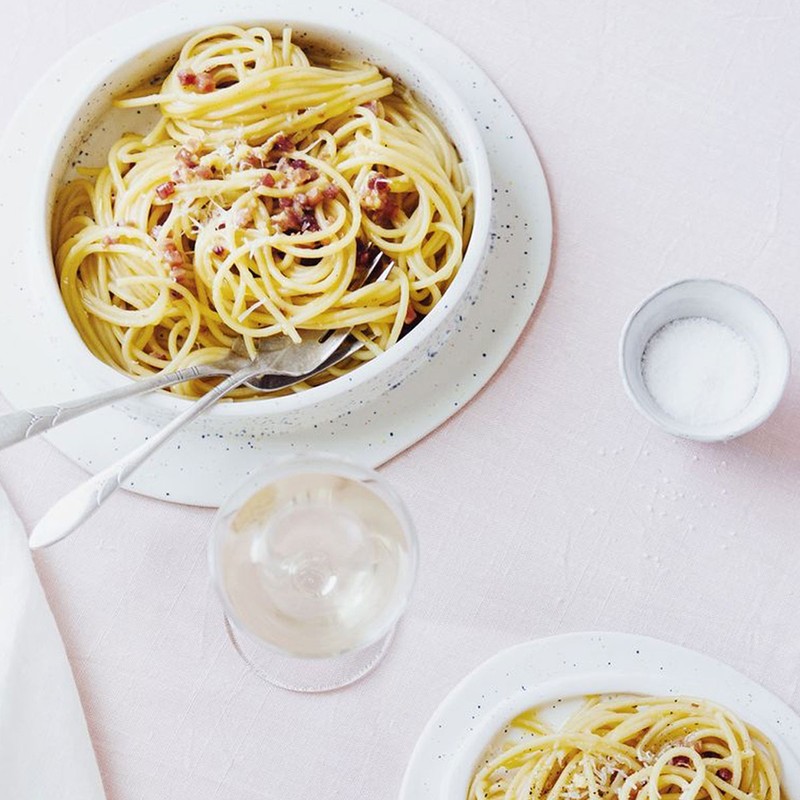
9 Chefs Share Their Carbonara Tips
Elia Sebregondi, Officina 00
“To make the best carbonara, you need to fry the guanciale in a pan until it is nice and crispy. Strain the pasta when it is half cooked. Keep cooking it in the pan where you made the guanciale crispy, adding starchy water until it is cooked al dente. Then, off the heat, add your egg, black pepper and pecorino mixture, so it doesn’t cook off completely and remains – bravo! – creamy. Carbonara is also best eaten quickly!”
Visit Officina00.co.uk
Eliano Crespi, Eataly
“Don't make carbonara using pancetta – only with guanciale because that's the original recipe. Similarly, make sure to use pecorino. It is best to use egg yolk for carbonara because it has got more fat content and emulsifies better. You need to sweat the guanciale on a low heat in a pan until nice and crispy but not burnt. You can't put it in a hot pan straight away or it will burn! Cook the pasta (my favourite is tortiglioni or rigatoni) in abundant salty water, drain the pasta al dente, cook it inside the pan where you sweat the guanciale, adding a little bit of cooking water, then add the egg and let it emulsify with the heat of the pasta. You do not want to cook the egg! Always serve the pasta al dente with abundant pecorino cheese and freshly cracked ground pepper.”
Visit Eataly.co.uk
Jacob Kenedy, Bocca Di Lupo
“No cream! Carbonara is a sauce of eggs, not cream – it should have no dairy in it other than the cheese. No parmesan! The only cheese to use is pecorino romano – fresher and more pungent, it’s like parmesan but made from ewe’s milk. Fortunately, it’s now more available in supermarkets than a few years ago. No bacon! Not even pancetta. Proper carbonara is made with guanciale – pig’s jowls cured like bacon, with a much piggier flavour. If you can’t get it, use pancetta lardons, but technically it won’t be carbonara (and it won’t be as good). No bland flavours! This is really three things. Fat isn’t always a friend to flavour. The only fat in the carbonara should come from the cheese, the guanciale and the egg – it’s a relatively light sauce and should incorporate some of the pasta’s cooking water. Salt is also key – it should be pretty salty, but more than enough salt will come from the pecorino and guanciale. However, you must make sure the pasta water is salty enough – at least 10-12g salt per litre of water. Finally, pepper. Carbonara is the balance of pungent pecorino, pungent guanciale and pungent pepper – all bound in an eggy veil. Use a lot of pepper, both in the sauce and on top.’
Visit BoccaDiLupo.com
James Mathieson, Bellefields
“The tips for the perfect carbonara are essentially: dried spaghetti not fresh; guanciale not pancetta; and a mixture of parmesan and pecorino. Guanciale is a much fattier pork than pancetta and it is not smoked. The idea is you cook the Guanciale in its own fat until it goes crispy – you get a much more subtle flavour from this as it is not smoked and does not overpower the cheese. Once crispy, remove from the pan and leave aside, but keep the fat in the pan. Cook pasta until perfectly al dente and put this into the pan with the fat and a small bit of the cooking water. In a separate bowl, mix egg yolks with the two cheeses and the black pepper to create a paste. Then – away from the heat – add this mixture to the pasta. Toss until creamy, then put the guanciale on top so it remains crispy. You can sprinkle some more pecorino on top if you are feeling bold.”
Visit Bellefields.com

Louis Korovilas, Pasta chef/creator, Ex-Bancone
“Don’t be afraid to bastardise carbonara by swapping ingredients. Changing guanciale for smoked duck ham is a favourite of mine, as is using grated pecorino sardo for the cheese. Don’t be tempted to go the cream route. Instead, go all in on eggs – up to 8 yolks for 3 people and plenty of starchy pasta water to let it down. Don’t cheap out on the eggs either – go Burford Brown or find a rich Italian yolk for a deep creamy consistency and vibrant colour. To prevent scrambling, I cook off my meat in a frying pan while toasting my ground black peppercorns in the same pan. Set aside so the pan is lukewarm. Then cook the bucatini (or pasta of your choice) in salted water, drain it and reserve a lot of the pasta water. Add the pasta to the pancetta pan with yolks and cheese, then let the warmth of the steamy pasta do the rest, adding pasta water little by little to adjust the consistency.”
Masha Rener, Lina Stores
“Starting with the right ingredients is imperative. Guanciale is better than bacon or pancetta – its fat provides the perfect consistency and creaminess to the dish. A long pasta shape such as bucatini or spaghetti is the best match for the sauce. The cheese needs to be a good quality pecorino romano. Only use egg yolks, not the whole egg. And never, ever use cream! Thinking of cooking tips, lightly toast the freshly ground pepper in the pan before adding the guanciale, so the meat has a slightly peppery taste from the start. No oil is needed and the fat of the guanciale is enough to flavour it beautifully. Two minutes before the pasta is fully cooked, drain it into the pan where you have crisped up the guanciale. Remove the pan from the heat and incorporate the ingredients quickly so you don’t end up with scrambled eggs!”
Visit LinaStores.co.uk
Tim Siadatan, Trullo & Padella
“Carbonara is won or lost in the final 30 seconds. Too much heat and it scrambles; too little heat and the cheese doesn’t melt enough and it’s grainy. First, though, you want the sauce silky and unctuous, so grate the parmesan super fine. This allows it to melt without too much heat. Then, whisk together the egg yolks and cheese. Next, fold cooked, hot pasta and a splash of hot pasta water into the cheese-egg mix and instantly stir until silky. Make sure you’re using either the dry pasta pan that’s still hot or something pre-heated because the residual heat of the pasta and pasta water will cook the egg but not scramble it. Add a splash more of the hot pasta water if the carbonara is too dry.”
Visit TrulloRestaurant.com & Padella.co
Andrea Zambrano, Ave Mario
“It’s the main ingredient, so egg yolk is one of the most important aspects of carbonara. The quantity is crucial: the right amount is two egg yolks for each person. As with all pasta, you have to keep the pasta water – the starchy water is how you get a perfectly creamy sauce. The best pasta shape for carbonara has to be bucatini, followed closely by rigatoni. For the cheese, do majority pecorino but also a little bit of parmesan. I find pecorino on its own is too salty. The guanciale needs to be very crispy. Also keep the fat from frying, then you can use that pan to prepare the sauce for extra flavour. Finally, on seasoning, lots of pepper is a must! Personally, I like to roast the whole black peppercorns and crush them myself with the back of a knife. For salt, just salt the cooking water for the pasta with 20g of salt per litre of water.”
Visit BigMammaGroup.com
Ed Templeton, Carousel
“Don't eat bacon? No problem. For his residency with us a few years back, Magnus Reid substituted pancetta with smoked eel for an epic take on the classic dish. It's an idea we've been riffing off ever since – it was a genuine revelation.”
Visit Carousel-London.com
DISCLAIMER: We endeavour to always credit the correct original source of every image we use. If you think a credit may be incorrect, please contact us at info@sheerluxe.com.









